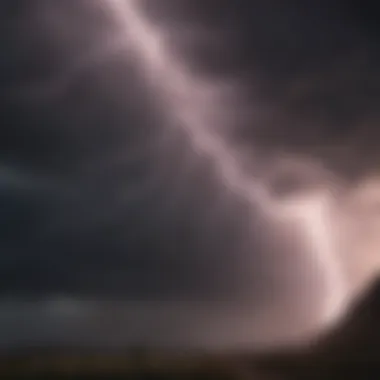The Lightning World: Understanding Atmospheric Phenomena


Intro
Lightning is a striking and fascinating phenomenon that captivates both scientists and the general public. This article aims to explore the complexities of lightning, delving into its formation, impact on the environment, and significance within atmospheric systems. Through analyzing scientific principles and uncovering advancements in lightning research, the article serves as a detailed guide for those interested in this natural force.
Understanding lightning begins with recognizing its formation process. It is not just a mere flash of light; it involves intricate interactions within the atmosphere. The article will address how charges accumulate in clouds, leading to the spark that creates lightning. It is essential to grasp this before diving into its effects on nature and technology.
The significance of lightning reaches far beyond its visual appeal. It plays a critical role in Earth's ecosystems and atmospheric chemistry. By assessing the dual nature of its impact—both destructive and beneficial—the narrative unfolds the broader implications of lightning on the environment.
Safety is another major point of focus. As lightning strikes can be lethal, the article will highlight advancements in safety measures and research efforts aimed at minimizing its dangers. Additionally, it touches on new technological tools used in studying lightning, helping to improve understanding and preparedness against its threats.
Lastly, the article provides a look into future directions in the study of lightning. With climate change and evolving weather patterns, understanding these atmospheric phenomena becomes increasingly vital. As such, upcoming trends in research will be discussed.
In the next sections, we will delve into the methodology used to gather information, address future directions in the field, and synthesize the findings presented, offering a comprehensive view of this awe-inspiring atmospheric force.
Understanding Lightning
Understanding lightning is crucial for grasping the complex interactions within our atmosphere. Lightning serves as a natural inquiry into not just electrical phenomena, but into the broader ecosystem of weather systems and environmental dynamics. The study of lightning illuminates how atmospheric electricity can influence climate, weather events, and the changes in ecosystems over time.
This section breaks down the mechanisms that give rise to various forms of lightning and highlights their significance. Understanding lightning contributes to our ability to predict severe weather and informs safety practices during thunderstorms. Thus, it is relevant for students, researchers, and professionals who deal with meteorology and environmental science.
The Science of Lightning Formation
The mechanisms behind lightning formation encompass several key processes. Each process is critical for appreciating the nature of lightning and its implications.
Electrostatic Principles
Electrostatic principles are the foundation of lightning formation. When particles collide within a storm cloud, they transfer electrical charge, resulting in a separation of positive and negative charges. This charge separation leads to an electrical imbalance. When the potential difference becomes significant, a discharge occurs, creating lightning.
A key characteristic of this process is the efficiency of charge transfer. This characteristic is beneficial because it helps explain the rapid development of lightning during storms. A unique feature of electrostatic principles is that they rely heavily on the atmospheric conditions, meaning they can vary from storm to storm. The major advantage is that they provide a simplified model for understanding complex phenomena. However, the disadvantage lies in the variability of conditions, making precise predictions challenging.
Charging Mechanisms in Clouds
Charging mechanisms in clouds are essential for understanding how various forms of lightning occur. In clouds, collisions between ice crystals and water droplets lead to charge separation. This process can involve different phases of water, such as liquid water and ice, which enhance charge development.
Key characteristics include the role of temperature and altitude in determining the charging process. This specificity makes it a significant element in lightning research. Unique features of charging mechanisms show that storms can exhibit different electrical behaviors based on structure and content. The advantage of understanding these mechanisms is the potential for improved weather prediction. On the downside, they often require sophisticated measurements to verify.
Stages of Lightning Development
Understanding the stages of lightning development provides insight into how lightning forms and progresses during a storm. It typically involves a series of steps including the initial charge build-up, the path formation, and the final discharge. Each of these stages marks a critical phase in the overall lifecycle of lightning.
The key characteristic here is the sequential nature of development, making it easier to study lightning over time. This sequential perspective is beneficial because it can help researchers identify patterns that lead to effective forecasting. A unique feature in this aspect is that debris and particles in the clouds can alter the paths formed by lightning. While the advantage is clear in predicting strikes, the disadvantage is that variability can lead to unexpected outcomes, complicating safety measures.
Types of Lightning
Exploring the various types of lightning is essential to comprehend its diverse manifestations and impacts. Each type has unique traits that contribute differently to atmospheric phenomena.
Cloud-to-Ground Lightning
Cloud-to-ground lightning is perhaps the most recognized form of lightning, striking from a cloud directly to the ground. This type occurs in numerous storm conditions and is responsible for most lightning-related injuries.
A key characteristic of cloud-to-ground lightning is its high voltage, which can reach billions of volts. This makes it a beneficial focus for safety and emergency protocols. The unique feature of its extensive reach means it can impact large areas. The major advantage lies in its prominence, allowing for easier study. However, the high energy can cause significant damage, necessitating strict safety measures.
Intracloud Lightning
Intracloud lightning occurs within a single cloud and often appears as flickering or strokes seen from the ground. This type plays an important role in storm dynamics, influencing energy distribution.
The key characteristic is that it often does not reach the ground. This makes it beneficial for studying cloud dynamics. The unique feature of intracloud lightning is its frequent occurrence, sometimes seen during stormy nights. An advantage is the less obvious danger it presents, though it can still indicate severe storm activity.
Cloud-to-Cloud Lightning
Cloud-to-cloud lightning involves electrical discharges between different clouds. This type typically generates brilliant visual displays across the sky and can traverse significant distances.


A defining characteristic is its ability to connect storms separated by considerable space. This provides valuable information about storm systems and their interactions. The unique feature here is that it may not be as understood as other types, but it still plays a role in overall electrification of the atmosphere. Understanding this can further refine forecasting models.
Rare Types of Lightning
Rare types of lightning encompass unusual phenomena such as ball lightning, heat lightning, and others. These varieties capture interest due to their incredible characteristics and mystery.
A key characteristic is their rarity, which makes them a subject of ongoing research and intrigue. These types offer a unique feature in their unpredictability and difficulty in study. They provide an opportunity for scientists to expand current models, but the challenge also includes lack of reliable data. The fascination with these forms can inspire further investigation and discovery.
Lightning Characteristics
Understanding lightning characteristics is crucial for comprehending its role in atmospheric sciences. Each aspect shines a light on how this phenomenon interacts with the environment and influences life on Earth. By studying the specific powers, patterns, and impacts of lightning, we gain insights that can help improve safety measures and ecological awareness.
Physical Properties
Temperature and Energy Output
Lightning is known for its extreme temperatures, often reaching up to 30,000 Kelvin. This heat contributes to the intense energy output associated with each lightning strike. The vast energy released during a bolt of lightning can be around one billion joules. This incredible energy has advantages; it generates heat and can cause rapid expansion of air, leading to thunder. However, such high temperatures can also pose risks, as they can ignite fires or cause injuries.
Visual and Acoustic Features
The visible aspect of lightning is its bright flash, which illuminates the sky. This brightness is due to the ionization of air, making it a vital indicator for identification. Acoustic features include the distinctive thunder sound, resulting from the rapid expansion and contraction of air. Both features make lightning a powerful subject of study and a spectacle for observers. However, the suddenness of these events can create hazards too for those unprepared for storms.
Duration and Frequency
The duration of a lightning flash is typically less than a second, but its impact can be long-lasting. Frequency can vary widely, with some regions experiencing lightning daily while others might see it only a few times a year. Understanding these factors is critical for predicting storms and implementing safety protocols. The short duration coupled with irregular frequency presents a challenge in studying lightning behavior and its effects on the environment.
Lightning Strikes: Patterns and Behavior
Strike Points and Ground Currents
The points at which lightning strikes are not random. Specific locations are more prone to strikes due to their topography or height compared to their surroundings. When lightning strikes the ground, it creates a current that can travel through the earth. This immediacy is a critical area of research as the current can cause damage to structures or pose risks to individuals nearby. Recognizing these patterns helps in developing effective lightning protection systems.
Frequency Distribution in Various Regions
Lightning strikes are not evenly distributed globally. Certain areas like Florida experience intense lightning activity compared to regions like the Northeast USA. This distribution results from unique climate conditions and geographical factors. By studying these patterns, scientists can assess risks and develop strategies for locals. It aids in resource allocation for emergency services too.
Temporal Patterns of Lightning Activity
Lightning does not occur uniformly throughout the day. There are increased occurrences in the afternoon and evening during the warm months. Studies show strong correlations between temperature, humidity, and lightning activity. Understanding these temporal patterns is key for weather forecasting. It also assists communities in preparing for lightning storms, arranging events, and implementing safety measures.
Impact on Natural and Built Environments
Effects on Flora and Fauna
Lightning plays a dual role in natural ecosystems. While its strikes can harm vegetation, they also foster new growth by igniting wildfires that clear dead material. Some plants rely on fires triggered by lightning to grow in nutrient-rich soil. Understanding these effects is beneficial for environmental management, especially in forested areas where lightning strikes are common.
Damage to Structures
Structures are at risk from lightning strikes, particularly tall buildings and other isolated structures. Direct strikes can result in severe damage, including fires and electrical surges that compromise infrastructure. Mitigating this damage requires an understanding of lightning protection systems and the implementation of best practices to minimize risks, making it essential for architects and builders.
Ecological Aftermath
The aftermath of a lightning strike can reshape local ecosystems. Strikes can lead to fires, which create new ecological niches while affecting existing life forms. Understanding these dynamics helps scientists predict ecological changes and manage natural resources. This consideration is important in conservation efforts, particularly in areas prone to wildfires caused by lightning.
The Role of Lightning in Weather Systems
Lightning plays a crucial part in atmospheric dynamics, particularly concerning weather systems. Understanding this role is vital as it connects various environmental processes, enhancing our reading of severe weather phenomena. The presence of lightning indicates active electrodynamic changes within clouds, often linked to storm behavior and rainfall patterns. As lightning occurs predominantly during thunderstorms, its study helps meteorologists better predict storm activities and improve public safety awareness.
Connection to Thunderstorms
Formation of Severe Weather


Lightning is closely associated with thunderstorms, a key element in severe weather formation. The strong updrafts within a thunderstorm can lead to intense electrical activity. This makes thunderstorms essential for producing lightning. The energy release during a lightning strike can alter local atmospheric conditions, supporting further severe weather development. However, this phenomenon also poses risks like flash flooding and hail. The unique aspect of its involvement in severe weather illustrates how thunderstorms serve as both creators and beneficiaries of lightning.
Lightning and Precipitation Correlation
There is a significant correlation between lightning occurrences and precipitation levels. When storms release clouds’ electric charges, it often leads to raindrop formation. In this context, lightning not only indicates the presence of precipitation but also influences the rate at which rain falls. This relationship is essential for proper forecasting and understanding local hydrological cycles. The characteristic of this correlation lies in its predictability - more lightning typically suggests more rain, aiding farmers and flood management efforts.
Association with Atmospheric Instability
Atmospheric instability creates conditions favorable for lightning generation. When warm, moist air rises and cools rapidly, it leads to the formation of cumulonimbus clouds, which are lightning-rich. This instability can also enable severe storms to develop, highlighting a key interaction in weather. However, associated dangers like strong winds and tornadoes must be considered. Understanding this characteristic of atmospheric dynamics is vital for comprehending how such storms manifest.
Influence on Climate and Atmospheric Chemistry
Lightning serves as an influential factor in climate and atmospheric chemistry. Its interactions with various atmospheric components can lead to significant environmental outcomes, such as nitrogen fixation.
Contribution to Nitrogen Fixation
Lightning helps convert nitrogen in the atmosphere into compounds that are usable by plants. This ability to enrich soil nutrients is beneficial for ecosystem health. Lightning-induced nitrogen fixation supports agricultural productivity and natural biodiversity. However, areas with frequent lightning might face imbalanced nitrogen cycles, raising ecological concerns.
Role in Ozone Formation
The electrical discharges from lightning contribute to ozone formation in the troposphere. While ozone is beneficial in the upper atmosphere, excess ground-level ozone can lead to air quality issues. This duality in the role of lightning highlights the complexities in atmospheric chemistry that necessitate careful monitoring and management strategies.
Effects on Global Energy Balance
The energy released during powerful lightning strikes can impact the local energy balance. Lightning alters heat distribution within the atmosphere, affecting weather patterns. These events provide insights into larger climatic shifts. Studying this relationship is important to understand energy transfers in our atmosphere and how they may contribute to climate change.
Understanding the role of lightning in weather systems provides crucial insights into both immediate weather phenomena and long-term climatic changes.
Technological Advances in Lightning Research
Technology significantly advances our understanding of lightning. These innovations enhance data collection methods, improve safety measures, and foster better understanding of atmospheric phenomena. Researchers use various tools to study lightning, leading to better predictions and mitigations of its impacts.
Remote Sensing Tools
Remote sensing plays a crucial role in monitoring lightning. It allows scientists to capture data from areas that are challenging to reach. This technology provides insights that help refine our understanding of lightning characteristics and behavior.
Lightning Detection Networks
Lightning Detection Networks are essential for monitoring lightning activity. They consist of a network of sensors strategically placed to capture electrical activity. The key characteristic of these networks is their high accuracy in detecting lightning strikes. Importantly, they offer real-time data about storm activity across extensive geographical areas.
One unique feature of Lightning Detection Networks is their ability to triangulate the location of strikes by measuring the time it takes for signals to reach multiple sensors. This positional accuracy is beneficial for understanding patterns that can forecast severe weather events. However, they may have limitations in remote or less populated areas where sensor coverage is sparse.
Satellite-Based Observation Technologies
Satellite-Based Observation Technologies are another tool for lightning research. Their primary function is to capture lightning from space, offering a global perspective of lightning activity. The key characteristic of these systems is wide spatial coverage, allowing continuous monitoring over vast areas.
These technologies provide images and data that can validate ground-based networks. A unique aspect of satellite observation is its capability to differentiate between lightning types. However, the spatial resolution may not always be as precise as ground systems, impacting some specific analyses.
Laboratory Studies
Laboratory studies are vital for replicating lightning phenomena in a controlled setting. These experiments help scientists comprehend the processes behind lightning formation. By creating mini lightning events, researchers can investigate various aspects that would be impossible to observe in nature.
Creating Lightning in Controlled Environments
Creating Lightning in Controlled Environments is a significant step in understanding its physics. This method allows researchers to analyze the fundamental processes involved in lightning formation. A notable characteristic is the ability to manipulate variables such as temperature and humidity, influencing the outcome of experiments.
The unique feature of these studies is their capacity to generate measurable and repeatable results, providing clear insights into lightning behavior. However, there are limitations regarding how well these controlled conditions represent real atmospheric events.
Simulating Atmospheric Conditions
Simulating Atmospheric Conditions is also critical for lightning research. Scientists use numerical models to recreate atmospheric environments conducive to lightning. The key characteristic of these simulations is their flexibility. Researchers can test various scenarios without waiting for specific atmospheric conditions to occur naturally.


One unique feature is the ability to combine multiple variables, such as pressure and temperature, to model different weather systems. This comprehensive approach allows deeper insights into lightning triggers. On the downside, these simulations may rely on assumptions that do not always align with real-world data, leading to potential discrepancies in findings.
Advances in lightning research technology are vital for improving our understanding of this atmospheric phenomenon. Through remote sensing tools and laboratory experiments, scientists can enhance safety measures and develop forecasts that protect life and property.
Lightning Safety and Mitigation Strategies
Understanding the dangers associated with lightning is crucial for both individuals and communities. Lightning safety and mitigation strategies are important as they can significantly reduce the risks of injuries and fatalities associated with lightning strikes. Enhancing public awareness is integral to safety, and integrating effective prevention tactics can save lives and limit property damage.
Understanding Lightning Hazards
Physical Injuries and Fatalities
Lightning poses severe risks to human life. Each year, dozens of people die, and hundreds suffer from injuries related to lightning. The most common injuries include severe burns and cardiac arrest, which can lead to long-term health consequences or even death. Understanding the extent of physical injuries due to lightning helps highlight the need for proper safety measures. Despite the rarity of such incidents, each event underlines the potential lethality of lightning.
The unique feature of lightning injuries is their unpredictability. Unlike other natural disasters, lightning strikes can happen suddenly, often catching individuals off guard. This aspect makes it essential to communicate effective preventive strategies clearly and persuasively. Encouraging people to take shelter indoors during thunderstorms can significantly lower the risk of exposure to lightning, thereby decreasing the chances of injury or fatality.
Property and Infrastructure Damage
Lightning can cause extensive damage to buildings and infrastructure. Fires ignited by strikes can lead to significant property losses, while surges can damage electrical systems and devices. The financial implications are serious, making it a critical area of focus for mitigation strategies. Property insurance often covers some risks related to lightning, but prevention remains far more effective than post-damage recovery.
Highlighting the risk of property damage created by lightning strikes adds a layer of urgency to the issue. Strategies such as proper electrical wiring and installation of lightning rods can be effective in minimizing potential damage. Though some infrastructure systems can be retrofitted with protection, costs can be substantial. However, investment in mitigation systems is often less than the cost of rebuilding after a strike.
Prevention Approaches
Lightning Protection Systems for Buildings
Implementing lightning protection systems for buildings is an effective strategy for mitigating potential damage. These systems often include lightning rods and grounding systems that redirect lightning strikes safely into the ground. Such solutions enhance the structural safety of homes and commercial properties and are crucial for both residential and high-rise buildings.
The key characteristic of these systems is their ability to minimize the risk of fire and electrical damage from lightning. They are a reliable choice as they not only protect individual structures but also contribute to broader community safety. Regular maintenance and inspection of lightning systems are essential for their effectiveness, as failure to do so can lead to ineffective protection during a strike.
Public Awareness Campaigns
Public awareness campaigns play a significant role in preventing lightning-related accidents. Educating people about the dangers of lightning and the importance of seeking shelter during storms can reduce injuries and save lives. These campaigns can be implemented by local governments, schools, or organizations and can take various forms, including workshops, social media initiatives, and informational pamphlets.
The key characteristic of public awareness is its potential to reach a wide audience. Campaigns that clearly relay safety messages are popular and can capture attention through various channels. A unique feature of these campaigns is their low cost and high potential impact. However, challenges exist, such as ensuring messages are effectively communicated and reaching those in areas prone to severe weather.
Emergency Response Protocols
Safety Guidelines During Thunderstorms
Developing and promoting safety guidelines during thunderstorms can improve community preparedness. Guidelines often emphasize the importance of finding shelter, avoiding electrical appliances, and refraining from standing near tall objects outdoors. Providing accessible resources detailing these practices can enhance public safety.
The key characteristic of these guidelines is their simplicity. They are easy to follow and can be communicated effectively through community meetings or social media. The unique feature of these protocols is their broad applicability to various settings, from urban to rural areas. This versatility enhances their relevance and potential for saving lives.
First Aid for Lightning Injuries
First aid knowledge for lightning injuries is critical, even if such injuries are rare. Understanding how to respond can significantly impact the survival rate of victims. The initial response may involve calling emergency services, checking for consciousness, and administering CPR if necessary. Proper first aid training can empower individuals to act during emergencies, which can be lifesaving.
The key characteristic of first aid knowledge is its accessibility. While many people have some training in basic first aid, specific guidelines for lightning-related incidents should be included in regular training sessions. The unique feature here is that first aid training often remains underutilized in communities, which can lead to increased severity of injuries during emergencies.
"Preparedness is paramount; understanding the risks and being ready to act can preserve life during thunderstorms."
In summary, enhancing safety and implementing mitigation strategies can have profound effects on reducing injuries and fatalities from lightning. With sufficient public awareness, infrastructure improvements, and emergency response protocols, individuals and communities can become more resilient against the hazards of lightning.
Epilogue
Understanding lightning is crucial for many reasons. Lightning is not just an atmospheric spectacle; it serves as a significant component of our ecosystem and weather systems. Addressing the scientific principles behind lightning formation provides insight into natural processes that govern our environment. It helps explain how atmospheric phenomena like thunderstorms develop and evolve.
Moreover, recognizing the types and characteristics of lightning enhances our ability to predict its occurrence. This is vital in fields such as meteorology, where accurate forecasts can save lives and property. For instance, knowing the distinction between cloud-to-ground lightning and intracloud lightning aids in assessing risks associated with different storm systems.
Additionally, understanding lightning's impact on both natural and built environments provides important information for planning and engineering. Structures, especially in lightning-prone regions, require proper protection systems to minimize damage. This includes lightning rods and surge protectors, which can significantly reduce risks.
The article also emphasizes the contributions of lightning to atmospheric chemistry, such as nitrogen fixation. This process is essential for maintaining soil fertility, thus linking lightning to agricultural productivity.
In terms of safety, having knowledge about lightning hazards and emergency response protocols is crucial. Lightning can cause serious injuries or fatalities, so public awareness campaigns and education on safe practices during thunderstorms are necessary.
Finally, technological advancements in lightning research open pathways for better detection and understanding of this phenomenon. Improved monitoring through remote sensing tools allows for real-time data collection, which is invaluable for researchers and meteorologists alike.
In summary, the exploration of lightning encompasses a wide range of aspects, from its formation and types to its ecological significance and safety measures. Each element reveals the intricate connection between atmospheric phenomena and our world, providing a deeper appreciation of nature's power. This understanding not only benefits researchers and educators but also informs policymakers and the general public about the dynamics of the atmosphere, enhancing preparedness and resilience in the face of weather-related challenges.







